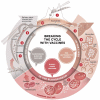RTS,S/AS01 vaccine (Mosquirix™): an overview
- PMID: 31545128
- PMCID: PMC7227679
- DOI: 10.1080/21645515.2019.1669415
RTS,S/AS01 vaccine (Mosquirix™): an overview
Abstract
Malaria is an illness caused by Plasmodium parasites transmitted to humans by infected mosquitoes. Of the five species that infect humans, P. falciparum exacts the highest toll in terms of human morbidity and mortality, and therefore represents a major public health threat in endemic areas. Recent advances in control efforts have reduced malaria incidence and prevalence, including rapid diagnostic testing, highly effective artemisinin combination therapy, use of insecticide-treated bednets, and indoor residual spraying. But, reductions in numbers of cases have stalled over the last few years, and incidence may have increased. As this concerning trend calls for new tools to combat the disease, the RTS,S vaccine has arrived just in time. The vaccine was created in 1987 and began pilot implementation in endemic countries in 2019. This first-generation malaria vaccine demonstrates modest efficacy against malaria illness and holds promise as a public health tool, especially for children in high-transmission areas where mortality is high.
Keywords: AS01; Plasmodium; RTS,S; adjuvant; malaria; vaccine.
Figures


References
-
- Ayanful-Torgby R, Quashie NB, Boampong JN, Williamson KC, Amoah LE.. Seasonal variations in Plasmodium falciparum parasite prevalence assessed by varying diagnostic tests in asymptomatic children in southern Ghana. PLoS One. 2018;13(6):e0199172. Epub 2018/06/16. PubMed PMID: 29906275; PMCID: PMC6003688. doi:10.1371/journal.pone.0199172. - DOI - PMC - PubMed
-
- Thwing J, Eisele TP, Steketee RW. Protective efficacy of malaria case management and intermittent preventive treatment for preventing malaria mortality in children: a systematic review for the lives saved tool. BMC Public Health. 2011;11(3):S14. Epub 2011/ 04/29. PubMed PMID: 21501431; PMCID: PMC3231887. doi:10.1186/1471-2458-11-S3-S14. - DOI - PMC - PubMed
-
- Dondorp AM, Lee SJ, Faiz MA, Mishra S, Price R, Tjitra E, Than M, Htut Y, Mohanty S, Yunus EB, et al. The relationship between age and the manifestations of and mortality associated with severe malaria. Clin Infect Dis. 2008;47(2):151–57. Epub 2008/06/07. PubMed PMID: 18533842. doi:10.1086/589287. - DOI - PubMed
-
- World malaria report 2018. Geneva, Switzerland: World Health Organization; 2018.
MeSH terms
Substances
LinkOut - more resources
Full Text Sources
Other Literature Sources
Medical
Research Materials
